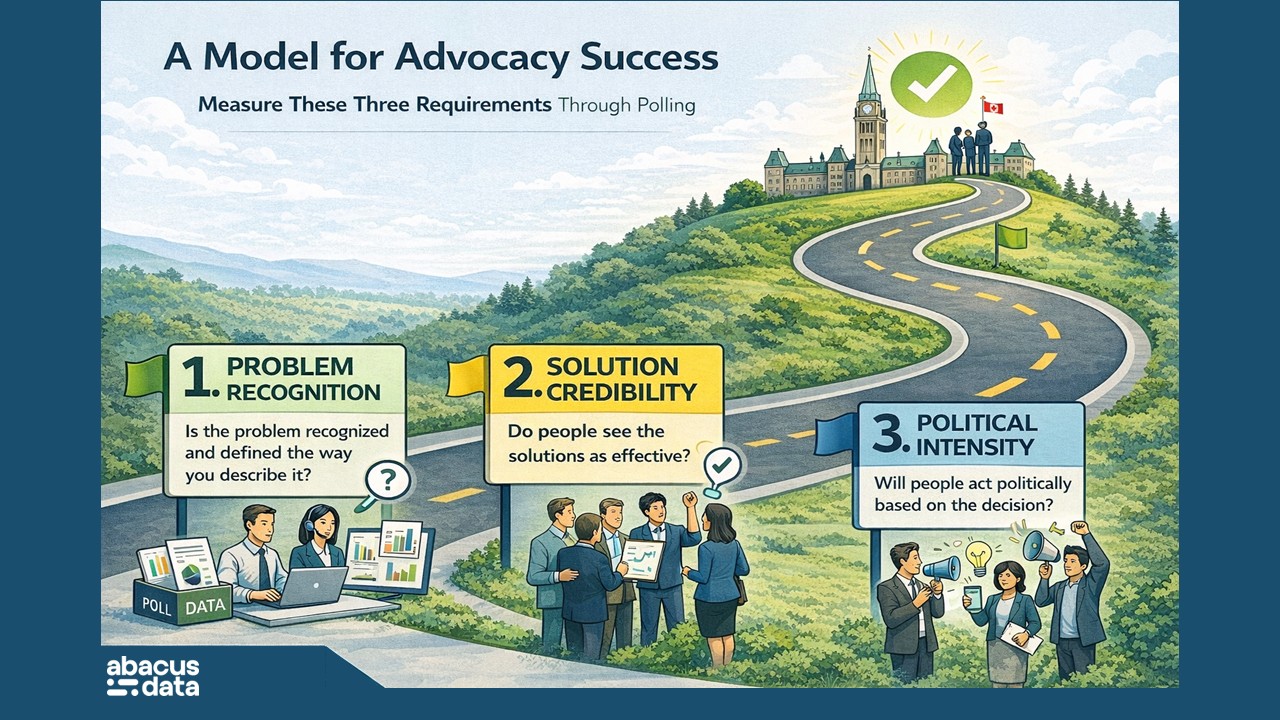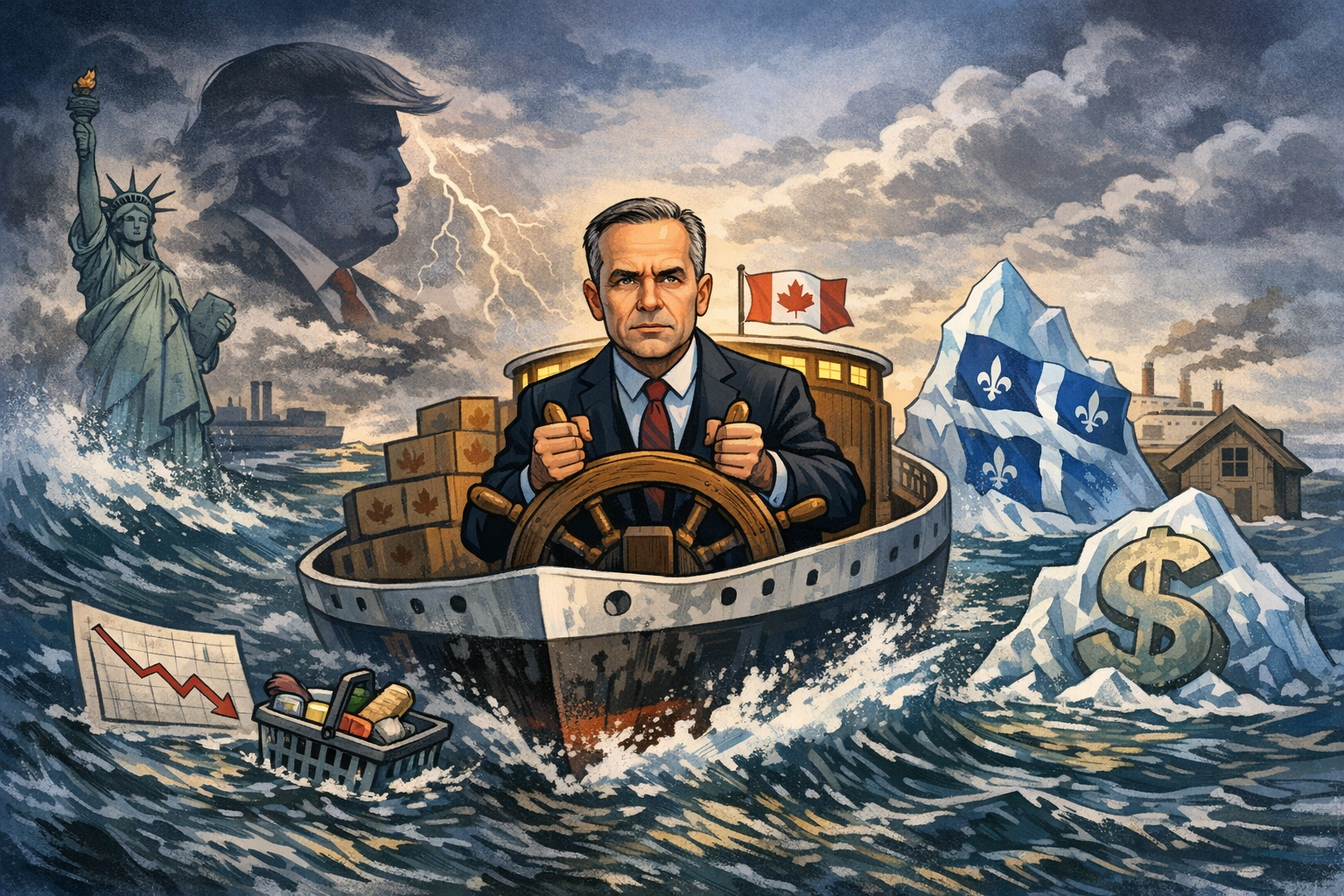Do you know who this is? The Implications of Recognizability in Canadian Politics
July 15, 2024
Yesterday, we released our latest tracking poll on Canadian politics that found the Conservatives ahead of the Liberals by 20-points.
Today, we are sharing something slightly different. On the weekend, the Toronto Star (our media partner), reported on some new questions we asked in the same survey conducted from July 4 to 9, 2024 with almost 2,000 Canadian adults.
Basically, we showed respondents several pictures of federal party leaders, senior cabinet ministers, and prospective Liberal leadership candidates and asked whether they could name the person in the picture.
Why do this?
One, it’s a different way of gauging awareness and familiarity with a political leader. If someone doesn’t recognize a picture of someone, it’s likely they don’t have a strong opinion of that person outside of the bias that might come with knowing what their job or title is.
For example, I may not know who the Minister of Housing is (it’s Sean Fraser) but when I’m asked my opinion of the Minister of Housing in a survey, my impressions may be entirely based on how I think they may be performing in the job. If I think housing is a crisis, I might then think the minister responsible must be doing a poor job.
Pollsters can also ask people whether they recognize a name or ask them to name the person who holds a particularly position. In our case, being able to recognize someone from a picture tells us a lot about what someone might know and think about that person.
Two, I think there is a lot we can learn about a whole lot of political decisions or phenomomen from this exercise. Three in particularly stand out to me.
First, there’s a lot of discussion about whether a cabinet shuffle will or won’t change Liberal fortunes. The Globe and Mail is now reporting that the PMO may shuffle Chrystia Freeland out of Finance. but If most Canadians can’t recognize a federal cabinet minister or even the Minister of Finance from a photo, should we expect a shuffle to make any meaningful difference to how people feel about the government or say, the Prime Minister?
Second, if Justin Trudeau does step down, who is best positioned to replace him? By testing familiarity and recognition of some of the candidates, we can get an instant read of how a particular candidate might perform and assess whether anyone has a shot of reviving Liberal fortunes. Perhaps even more useful, tt also will tell us whether it’s even possible to know how Canadians would react to a new leader unless that new leader is already a household name.
How can you know how a new Liberal would do, if say only 1 in 5 people even can recognize them in a picture?
Finally, by testing photo recognition, we can understand whether impressions of Pierre Poilievre and the Conservative lead in the polls is firm or filmsy. Are Canadians, as the Prime Minister argued, “not in decision mode” or do they have a good sense of who Mr. Poilievre is and can recognize him when he appears on their screens?
So I think there’s a lot of value from this very simple exercise.
Here are the results:
Federal Party Leaders
Given the profile of federal party leaders, it’s not surprising that most Canadians can recognize a picture of the leader of Canada’s three largest parties (in terms of vote share). 98% recognize a picture of Justin Trudeau, 84% recognize NDP Leader Jagmeet Singh, and 66% recognize a photo of Conservative Leader Pierre Poilievre.
Given that Poilievre has not fought a national election and has been Conservative leader for less than 2 years while Trudeau is Prime MInister and has been leader since 2013 and Singh has been NDP leader since 2018 and fought two national campaigns, Poilievre is actually doing pretty well in terms of recognition.
But still, 1 in 3 Canadians don’t recognize Pierre Poilievre when they see a picture of him.
About half of Canadians recognize Elizabeth May when they see a picture of her despite her being leader since 2006 and only 1 in 5 Canadians can name BQ Leader Blanchet when they see a picture of him including 49% in Quebec.
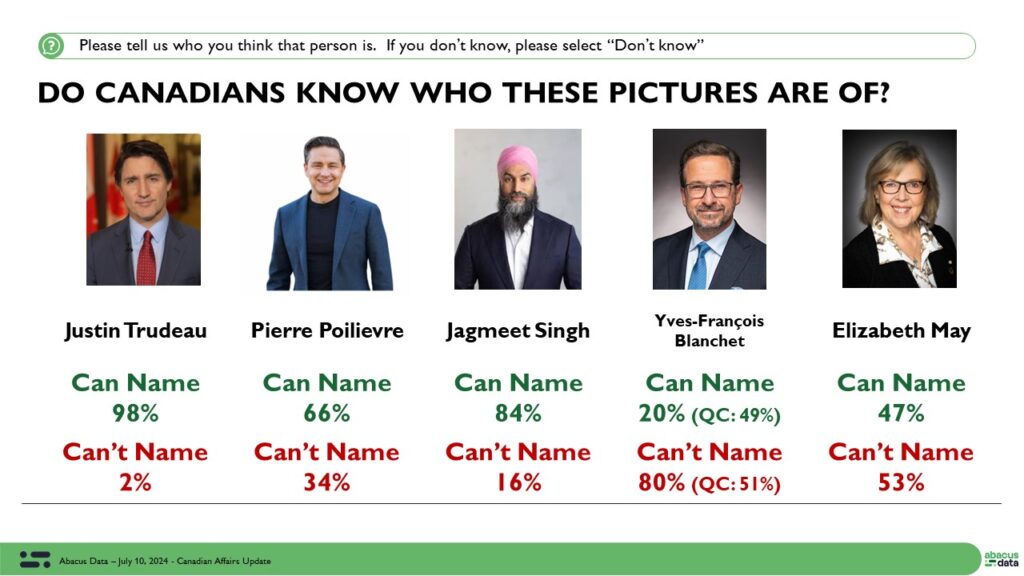
Liberal Leadership Candidates and Cabinet Ministers
When we test several cabinet minister and possible leadership candidates, the results are quite different. It’s a stark reminder of much Canadian politics can be in a bubble and how little familiarity Canadians have with anyone who is a federal party leader.
Of the six people we test, Finance Minister Chrystia Freeland is by far the most recognizable. 39% could accurately identify who was in the picture (her name or her position) but 61% could not. Foreign Minister Melanie Joly was next at 20% followed by Treasury Board President Anita Anand at 19%, Mark Carney at 7%, Housing Minister Sean Fraser at 4% and Public Safety Minister Dominic Leblanc at 4%.
These results clearly indicated that none of these people are well known, household names. The vast majority of Canadians cannot literally pick them out of a lineup.
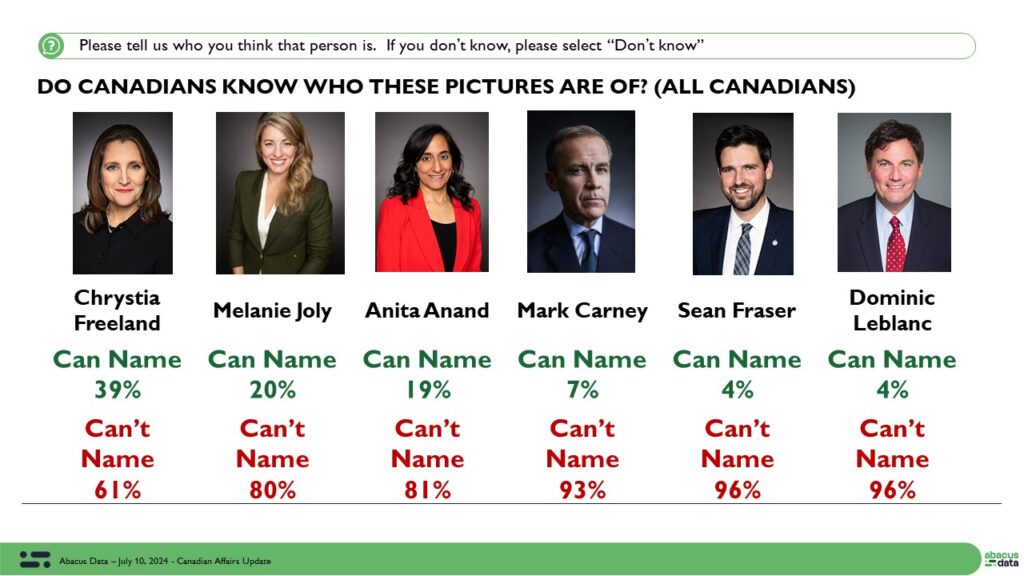
What about when look at those who would vote Liberal today? Does that change anything? Not really.
For current Liberal supporters, picture recognition is similar for Chrystia Freeland (39%), slightly higher for Melanie Joly (26%), lower for Anita Anand (14%), marginally higher for Carney (10%), Fraser (8%), and Leblanc (7%).
There is noteworthy that the female cabinet minister or prospective candidates are more recognizable than the male ones.
But the point here is that even among Liberal supporters – those most likely to look and be similar to those who might vote in a leadership race – can’t even identify possible contenders for the leadership if Trudeau was to step down.
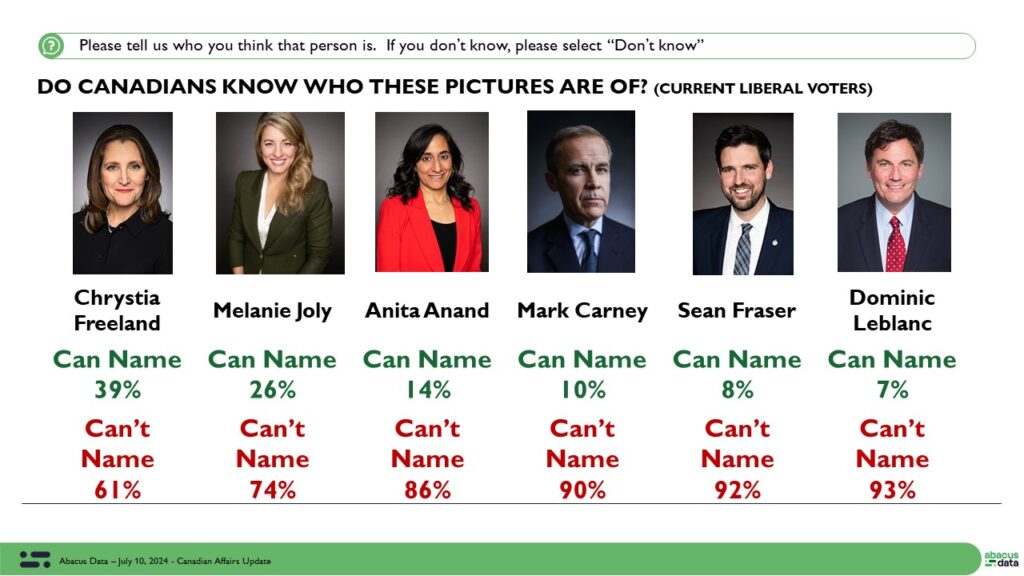
So what does this all mean?
Let me go through the three areas where I think these results tell us something useful.
Cabinet Shuffle = Liberal Revival
I don’t believe a cabinet shuffle, even one that moves Minister Freeland out of Finance changes a single thing for the Liberals in terms of public opinion. Why? Because most Canadians have no idea who is in cabinet, what someone in cabinet does, and why a different cabinet might lead to different policies or outcomes.
The only person in that cabinet in which more than 40% of Canadians recognize is the Prime Minister. And based on our polling, you cannot separate how people feel about the Liberal government from how they feel about the Prime Minister.
Consider this: 78% of Canadians who have a positive view of the federal government also have a positive view of the PM.
91% of Canadians who have a negative view of the government also have a negative view of the PM.
Only 25% of Canadians don’t align their views of the PM with their views of his government. And the LPC only gets 23% of the vote among them.
Want to change how people feel about the Liberal government? You’ve got to change the leader. Shuffling people no one knows about or has an impression of will do nothing. It didn’t last summer and it won’t this summer.
Liberal Leadership Race & Liberal Fortunes in the Future
So let’s imagine Prime Minister Trudeau does announce he won’t run again and asks the Liberal Party to start a leadership race. Will a new leader change Liberal fortunes? I don’t think there’s any research we can do to honestly and effectively test that.
Why? Because as we’ve shown here, any of the would-be successors are unknown to the vast majority of Canadians. Let’s say Sean Fraser becomes Prime Minister and Liberal leader and Canadians, when they are exposed to him, like him. That might change how they feel about their choices. The same is true for any one of the six people we tested.
I don’t believe we can guarantee that those who voted Liberal in the past but today are voting Conservative or NDP are gone for good. Most have left the Liberals because they want change. They don’t like Trudeau and can’t imagine what a government led by someone else might look like and what it might do.
Is Pierre Poilievre’s Support Flimsy?
This exercise also gives us some good intel on whether Conservative support is firm or flimsy. Given that 1 in 3 Canadians can’t recognize a picture of Mr. Poilievre, there is some evidence that some people’s impression of him is not well formed. It may not be too late for the Liberals to try and redefine him or define him with those who don’t know much about him.
But there’s also evidence that Poilievre is in a solid place and his support is firm.
When we look at the difference between those who recognize him in the photo and those that don’t, I see two things of note. 44% of these folks have a positive view of him compared with 43% who have anegative view. That +1 net favourable is far better than the -35 facing the PM (who 98% of Canadians recognize and know).
Among those who don’t recognize Poilievre, 26% have a positive impression of him, 28% negative and 30% neutral. That tells me that by just mentioning he is the Conservative leader when we measure leader impressions produces a fair neutral result. Even if people don’t know who Pierre Poilievre is, being Conservative leader is a net neutral proposition.
But most important, among those who recognize a picture of Poilievre, the Conservatives lead by 25-points over the Liberals with 12% undecided. Among those who don’t recognize him, the Conservatives still lead, albeit by a smaller 4-point margin.

The point of all of this is one, when people see a picture or video of Poilievre, most already know it’s him, what is role is, and half of those folks like him.
Two, while there may still be some folks whose impressions of Poilievre can be shaped, we know the Conservatives have far more money than all the parties combined to continue to shape his image as they see fit.
Finally, as I’ve noted in the past, 98% know who Justin Trudeau is. Impressions of him are well-formed, firm, and likely unchangeable. Poilievre is likely in a far better position today than either of the previous two Conservative leaders. If the Liberals think they will be able to shift opinions of him in about a year with little money and a deeply unpopular messenger (Mr. Trudeau), I don’t think they are looking at the same data I am.

Methodology
The survey was conducted with 1,989 Canadian adults from July 4 to 9, 2024. A random sample of panelists were invited to complete the survey from a set of partner panels based on the Lucid exchange platform. These partners are typically double opt-in survey panels, blended to manage out potential skews in the data from a single source.
The margin of error for a comparable probability-based random sample of the same size is +/- 2.1%, 19 times out of 20.
The data were weighted according to census data to ensure that the sample matched Canada’s population according to age, gender, educational attainment, and region. Totals may not add up to 100 due to rounding.
This survey was paid for by Abacus Data Inc.
Abacus Data follows the CRIC Public Opinion Research Standards and Disclosure Requirements that can be found here: https://canadianresearchinsightscouncil.ca/standards/
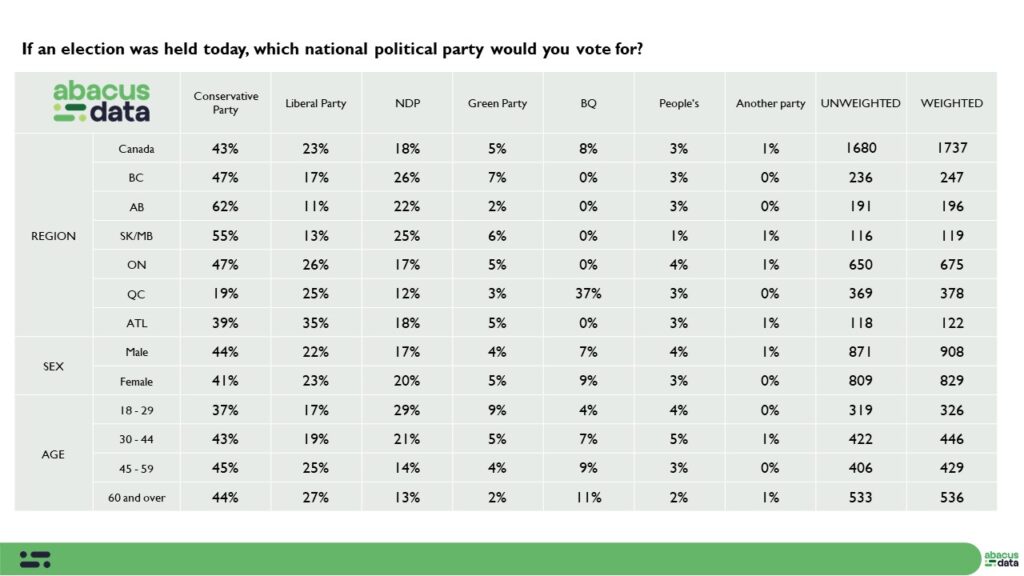
ABOUT ABACUS DATA
We are Canada’s most sought-after, influential, and impactful polling and market research firm. We are hired by many of North America’s most respected and influential brands and organizations.
We use the latest technology, sound science, and deep experience to generate top-flight research-based advice to our clients. We offer global research capacity with a strong focus on customer service, attention to detail, and exceptional value.
And we are growing throughout all parts of Canada and the United States and have capacity for new clients who want high quality research insights with enlightened hospitality.
Our record speaks for itself: we were one of the most accurate pollsters conducting research during the 2021 Canadian election following up on our outstanding record in the 2019, 2015, and 2011 federal elections.
Contact us with any questions.
Find out more about how we can help your organization by downloading our corporate profile and service offering.


